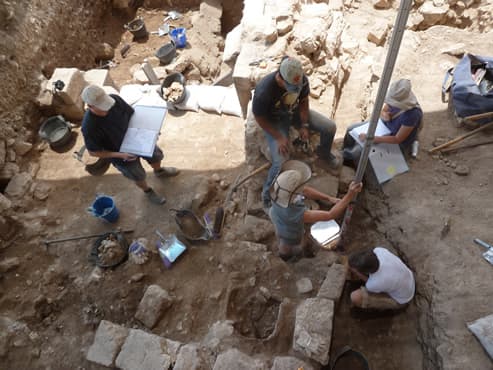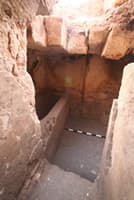Mt. Zion dig reveals possible Second Temple Period priestly mansion, abandoned and preserved

In excavating sites in a long-inhabited urban area like Jerusalem, archaeologists are accustomed to noting complexity in their finds – how various occupying civilizations layer over one another during the site’s continuous use over millennia. But when an area has also been abandoned for intermittent periods, paradoxically there may be even richer finds uncovered, as some layers have been buried and remain undisturbed by development.
Such appears be the case at an archaeological dig on Jerusalem’s Mount Zion, conducted by the University of North Carolina at Charlotte, where the 2013 excavations have revealed the well-preserved lower levels of what the archaeological team believes is an Early Roman period mansion(first century CE), possibly belonging to a member of the Jewish ruling priestly caste.
If the mansion does prove to be an elite priestly residence, the dig team hopes the relatively undisturbed nature of the buried ruin may yield significant domestic details concerning the rulers of Jerusalem at the time of Jesus.
 Particularly important in the season’s discoveries were a buried vaulted chamber that has proven to be an unusual finished bathroom (with bathtub) adjacent to a large below-ground ritual cleansing pool (mikveh) — only the fourth bathroom to be found in Israel from the Second Temple period, with two of the others found in palaces of Herod the Great at Jericho and Masada.
Particularly important in the season’s discoveries were a buried vaulted chamber that has proven to be an unusual finished bathroom (with bathtub) adjacent to a large below-ground ritual cleansing pool (mikveh) — only the fourth bathroom to be found in Israel from the Second Temple period, with two of the others found in palaces of Herod the Great at Jericho and Masada.
Shimon Gibson, the British-born archaeologist co-directing the UNC Charlotte excavation, notes that the addition of the bathroom to the mikveh is a clear sign of the wealth and status of the resident.
“The bathroom is very important because hitherto, except for Jerusalem, it is usually found within palace complexes, associated with the rulers of the country,” Gibson said.“We have examples of bathrooms of this kind mainly in palatial buildings.”
The other example of a contemporary mikveh with an attached bathroom is at a site excavated in Jerusalem in the nearby Jewish Quarter.“A bathroom that is almost a copy of ours was found in an excavation of a palatial mansion,” noted Gibson. “It is only a stone’s throw away and I wouldn’t hesitate to say that the people who made that bathroom probably were the same ones who made this one. It’s almost identical, not only in the way it’s made, but also in the finishing touches, like the edge of the bath itself.”
“The building in the Jewish Quarter is similar in characteristics to our own with an inscription of a priestly family,” Gibson added. “The working theory is that we’re dealing also with a priestly family.”
Gibson notes that there are other details about the site that suggest that its first century residents may have been members of the ruling elite.“The building that we are excavating is in the shadow — immediately to the southeast — of the very, very large palace of Herod the Great, his compound and the later seat of the Roman governors (praetorium).”
The location is a strong indication of a high-status resident. “Whoever lived in this house would have been a neighbor and would have been able to pop into the palace,” he speculated.
While also cautious about reaching premature conclusions, dig co-director James Tabor, a UNC Charlotte scholar of early Christian history, believes there might be significant historical information uncovered, should the building turn out to be a priestly residence.
“If this turns out to be the priestly residence of a wealthy first century Jewish family, it immediately connects not just to the elite of Jerusalem – the aristocrats, the rich and famous of that day – but to Jesus himself,” Tabor said. “These are the families who had Jesus arrested and crucified, so for us to know more about them and their domestic life — and the level of wealth that they enjoyed — would really fill in for us some key history.”
Though the artifacts found this season are still being evaluated, one set of items in particular stand out as highly unusual: a large number of murex shells, the largest number ever found in the ruins of first-century Jerusalem. Species of murex (a genus of Mediterranean sea snail) were highly valued in Roman times because of a rich purple dye that could be extracted from the living creature.
“This color was highly desired,” Gibson said. “The dye industry seems to be something that was supervised by the priestly class for the priestly vestments and for other aspects of clothing which were vital for those who wished to officiate in the capital precincts.”
Why anyone in Jerusalem would be in possession of such “a very large quantity” of murex shells, however, remains a mystery to the excavation team, since the shells are not involved in the actual dye making process. Gibson hypothesizes that the shells may have been used to identify different grades of dye, since the quality of the product can vary from species to species. Some species are used to make a turquoise blue dye.
“It is significant that these are household activities which may have been undertaken by the priests,” Gibson said. “If so, it tells us a lot more about the priests than we knew before. We know from the writings of Josephus Flavius and later rabbinical texts about their activities in the area of the Jewish temple, but there is hardly any information about their priestly activities outside the holy precinct. This is new information, and that is quite exciting. We might find in future seasons further aspects of industries which were supervised by these priestly families.”
The domestic details of the first-century Jewish ruling class may yield insights into New Testament history, Tabor notes. “Jesus, in fact, criticizes the wealth of this class,” Tabor said. “He talks about their clothing and their long robes and their finery, and, in a sense, pokes fun at it. So for us to get closer to understanding that – to supplement the text – it could be really fascinating.”
Read more about this story online.